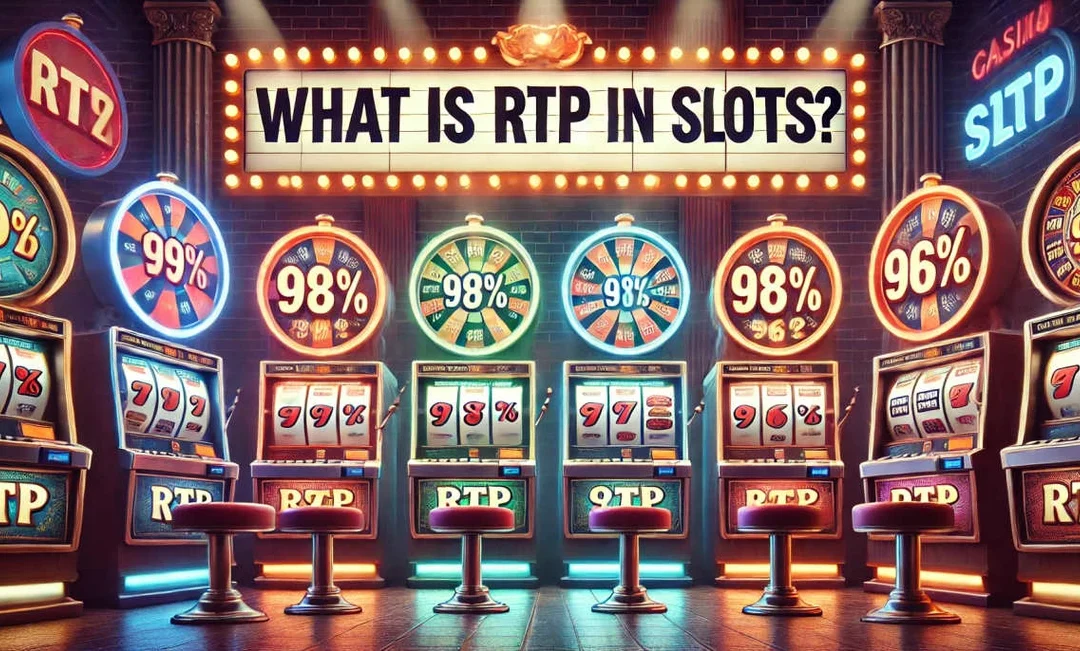Online slots are a popular form of entertainment, offering players the chance to win big with just a spin. But behind the flashing lights and exciting themes lies a crucial factor that can influence your success: Return to Player, or RTP. Understanding RTP is essential for anyone looking to maximize their winnings and make informed decisions while playing. RTP is a percentage that indicates how much of the total money wagered on a slot machine will be paid back to players over time. It’s a key metric that can help you gauge the potential profitability of a game. In this post, we’ll delve into the intricacies of RTP, exploring how it affects your winnings, how it’s calculated, and how it varies across different slot games. We’ll also discuss its role in strategy, the differences between high and low RTP slots, and how casinos use it to attract players. By the end, you’ll have a comprehensive understanding of RTP and its impact on your slot gaming experience.
How RTP Affects Your Winnings in Online Slots
RTP, or Return to Player, is a critical factor in determining your potential winnings in online slots. It represents the percentage of total bets that a slot machine is expected to return to players over time. For instance, if a slot has an RTP of 96%, it means that, on average, players can expect to receive $96 back for every $100 wagered. However, it’s important to note that RTP is a long-term average and doesn’t guarantee individual results. In the short term, players may experience significant wins or losses. Higher RTP percentages generally indicate better odds for players, as more of their wagers are returned over time. Therefore, choosing slots with higher RTPs can increase your chances of winning in the long run. However, RTP is just one aspect of a slot’s payout potential. Other factors, such as volatility and bonus features, also play a role in determining your overall experience and potential winnings. Understanding how RTP affects your winnings can help you make more informed decisions when selecting which slots to play.
<h2>Understanding the Calculation of Return to Player</h2>
The calculation of Return to Player (RTP) is a complex process that involves analyzing the game’s mechanics and payout structure. RTP is expressed as a percentage and is calculated by dividing the total amount returned to players by the total amount wagered on the game. This calculation is typically performed over millions of spins to ensure accuracy and reliability. Game developers use sophisticated algorithms and mathematical models to determine the RTP of a slot. These models take into account various factors, such as the number of paylines, the frequency of winning combinations, and the size of payouts. It’s important to understand that RTP is a theoretical value, meaning it represents the expected return over an extended period. Individual gaming sessions may deviate significantly from the RTP due to the random nature of slot games. Casinos and regulatory bodies often test and verify the RTP of slot games to ensure fairness and transparency. By understanding how RTP is calculated, players can gain insight into the potential profitability of a slot and make more informed decisions when choosing which games to play.
Comparing RTP Percentages Across Different Slot Games
RTP percentages can vary significantly across different slot games, making it essential for players to compare them before deciding which games to play. Generally, online slots offer RTPs ranging from 90% to 98%, with some games even exceeding this range. Higher RTP percentages indicate better odds for players, as they suggest a greater portion of wagers will be returned over time. When comparing RTPs, it’s important to consider the type of slot game you’re interested in. Classic slots, video slots, and progressive jackpot slots may have different RTP ranges due to their unique features and payout structures. For example, progressive jackpot slots often have lower RTPs because a portion of each bet contributes to the jackpot prize. Additionally, some slots may offer variable RTPs, meaning the percentage can change based on the player’s bet size or the activation of certain features. By comparing RTP percentages across different slot games, players can identify those with the best potential for returns and tailor their gaming experience to suit their preferences and goals.
The Role of RTP in Slot Game Strategy
RTP plays a crucial role in developing a successful slot game strategy. By understanding the RTP of a slot, players can make more informed decisions about which games to play and how to manage their bankroll. A higher RTP generally indicates better odds for players, making it a key factor to consider when selecting a slot game. However, RTP should not be the sole focus of your strategy. Other factors, such as volatility, bonus features, and personal preferences, should also be taken into account. For instance, players who prefer frequent, smaller wins may opt for low-volatility slots with higher RTPs, while those seeking larger payouts may choose high-volatility slots with lower RTPs. Additionally, players should consider their budget and gaming goals when developing a strategy. By balancing RTP with other factors, players can create a well-rounded approach that maximizes their enjoyment and potential winnings. Ultimately, understanding the role of RTP in slot game strategy can help players make more informed decisions and enhance their overall gaming experience.
High RTP Slots vs. Low RTP Slots: Which to Choose?
Choosing between high RTP slots and low RTP slots depends on your gaming preferences and goals. High RTP slots generally offer better odds for players, as they return a larger portion of wagers over time. This makes them an attractive option for those seeking consistent returns and longer gaming sessions. However, high RTP slots may also have lower volatility, meaning they offer smaller, more frequent wins. On the other hand, low RTP slots often come with higher volatility, providing the potential for larger payouts but with less frequent wins. These slots may appeal to players who enjoy the thrill of chasing big jackpots and are willing to take on more risk. When deciding between high and low RTP slots, consider your budget, risk tolerance, and gaming objectives. If you prefer a steady, predictable gaming experience, high RTP slots may be the better choice. Conversely, if you’re willing to take on more risk for the chance of a big win, low RTP slots might be more suitable. Ultimately, the choice between high and low RTP slots depends on your personal preferences and gaming style.
How Casinos Use RTP to Attract Players
Casinos use RTP as a marketing tool to attract players by highlighting the potential returns of their slot games. By offering games with higher RTP percentages, casinos can appeal to players seeking better odds and a more rewarding gaming experience. Many online casinos prominently display the RTP of their slot games, allowing players to make informed decisions about which games to play. Additionally, some casinos may offer promotions or bonuses on high RTP slots to entice players to try them out. By showcasing the RTP of their games, casinos can build trust with players and demonstrate their commitment to fairness and transparency. However, it’s important for players to remember that RTP is just one aspect of a slot’s appeal. Other factors, such as game themes, features, and volatility, also play a role in attracting players. By understanding how casinos use RTP to attract players, you can make more informed decisions about which games to play and take advantage of promotions that align with your gaming preferences.
RTP and Volatility: How They Interact in Online Slots
RTP and volatility are two key factors that interact to shape the overall experience of online slots. While RTP represents the percentage of total bets returned to players over time, volatility refers to the frequency and size of payouts. High volatility slots offer larger payouts but less frequently, while low volatility slots provide smaller, more frequent wins. The interaction between RTP and volatility can influence your gaming experience and potential winnings. For example, a high RTP slot with low volatility may offer consistent returns with smaller payouts, making it ideal for players seeking steady gameplay. Conversely, a low RTP slot with high volatility may provide the thrill of chasing big wins, appealing to players willing to take on more risk. Understanding the relationship between RTP and volatility can help you choose slots that align with your gaming preferences and goals. By considering both factors, you can tailor your gaming experience to suit your desired level of risk and potential rewards.
Misconceptions About RTP in Online Gaming
There are several misconceptions about RTP in online gaming that can lead to confusion among players. One common misconception is that RTP guarantees individual results. In reality, RTP is a theoretical value that represents the expected return over an extended period. Individual gaming sessions may deviate significantly from the RTP due to the random nature of slot games. Another misconception is that higher RTP slots always result in more frequent wins. While higher RTP percentages indicate better odds for players, they do not guarantee the frequency or size of payouts. Volatility plays a significant role in determining the payout structure of a slot game. Additionally, some players may believe that RTP can be manipulated by casinos to favor the house. However, reputable casinos and game developers adhere to strict regulations and testing to ensure fairness and transparency. By understanding these misconceptions, players can make more informed decisions and develop realistic expectations when playing online slots.
How to Find the RTP Information for a Slot Game
Finding the RTP information for a slot game is essential for making informed decisions about which games to play. Most online casinos provide RTP information in the game details or paytable section. This information is usually displayed as a percentage, indicating the expected return to players over time. Additionally, many game developers include RTP information on their official websites, allowing players to verify the accuracy of the data. Some online gaming forums and review sites also provide RTP information for popular slot games, offering insights and comparisons to help players choose the best options. When searching for RTP information, it’s important to ensure that the source is reputable and reliable. By accessing accurate RTP data, players can make more informed decisions about which slots to play and tailor their gaming experience to suit their preferences and goals.
The Impact of RTP on Long-term Slot Play
RTP has a significant impact on long-term slot play, influencing the overall profitability and enjoyment of the gaming experience. Over an extended period, slots with higher RTP percentages are more likely to return a larger portion of wagers to players, making them a more attractive option for those seeking consistent returns. However, it’s important to remember that RTP is a theoretical value and does not guarantee individual results. In the short term, players may experience significant wins or losses, regardless of the RTP. For long-term slot play, it’s essential to consider other factors, such as volatility, bonus features, and personal preferences, in addition to RTP. By balancing these factors, players can create a well-rounded approach that maximizes their enjoyment and potential winnings. Understanding the impact of RTP on long-term slot play can help players make more informed decisions and enhance their overall gaming experience.
RTP is a vital component of online slots, influencing your potential winnings and gaming strategy. By understanding RTP, you can make informed decisions about which games to play and how to manage your bankroll. Remember, RTP is a long-term average, not a guarantee of individual results. Consider other factors like volatility and personal preferences when choosing slots. Casinos use RTP to attract players, but it’s just one aspect of a game’s appeal. By comparing RTP percentages and understanding their impact, you can tailor your gaming experience to suit your goals. With this knowledge, you can enhance your enjoyment and potential success in online slots.


